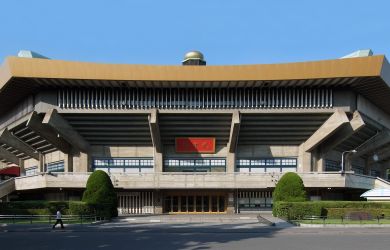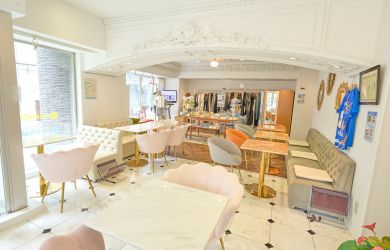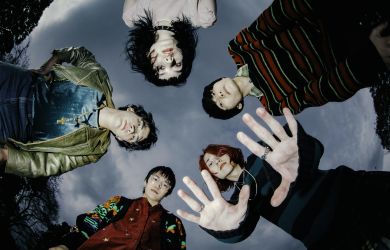
September 18, 2003
City by the Sea
Once a pirate haunt, the port town of Onomichi in the Inland Sea still houses an intriguing array of temples, and a surprising number of cats and cat lovers. Stephen Mansfield goes exploring.
By Metropolis
Originally published on metropolis.co.jp on September 2003

Photos by Stephen Mansfield
Viewed from the hilltop site of Senko-ji temple in the port of Onomichi, many of the Seto Inland Sea’s 750 inhabited islands look like green and charcoal-colored stones set in silver waters, one stacked behind the other as they vanish into the haze. It’s a treat to see such beautiful seascapes in a region blighted by petrochemical plants, squalid ports and giant, largely unused bridges.
Donald Richie, passing through Onomichi in the late ’60s, described it at length in his magisterial The Inland Sea. Noting the crescent of old wooden houses along the waterline, several of which are still there, he observed that “Onomichi is from the sea a very Chinese-looking city, the houses emptying directly onto the water.”
Pirate tales
The Inland Sea’s principal middle port, Onomichi was once the haunt of pirates who even had the audacity to build a fortress there. The narrow stretch of water between the town and Mukaijima-the island just across the strait-was easily defended, booty could be brought up the town’s discreet little creek, goods hidden in storehouses and caves. Its complex warren of lanes and paths were augmented with countless escape routes. Today, even with the aid of a decent map, it still takes a good half-day to decipher this long, narrow town built in the only space available between the steep mountain and sea.
Onomichi is really two divisible towns: an older, more permanent teramachi (temple town), with an appropriate pace of life and a strong sense of order and purpose to go with it, and the more polymorphous working town. A railway transects the two, the older town rising in stone steps and paths from the level crossings of the JR Sanyo line.
If the new town is rundown modern, the old is properly weathered and timeworn. There are antique smells as well: incense, drains, mildew, mosquito coils-the older, green variety-sawed timber, cat’s fur…and cat’s piss. Onomichi is a city of cats. For cat lovers-and there seem to be an inordinate number of them in Onomichi-the litter of unsightly trays, the fish heads, messily pawed canapes, and cans of reeking cod and tuna oil, do not appear unsightly, just part of the paraphernalia of feline care. There is even a Maneke-neko Museum-perhaps the only town in Japan with such an institution-dedicated to those tacky models of cats’ beckoning paws employed by restaurant owners and the like.

Murray’s Handbook described Onomichi some 90 years ago as “a town of fine, though decaying temples.” One of the charms of the town is that its historical buildings are adequately maintained, but not pampered into showcase sterility. A good place to start an exploration on foot is Senko-ji. The scarlet temple sits precariously on the rock face here, bulging with votive tablets, devotional offerings and moldering Jizo statues. Downhill from here leads you along the so-called “literary path,” a series of winding lanes and alleys inscribed with stone plaques to famous figures in Japanese fiction. Some, including the exemplary Fumiko Hayashi-her statue stands outside the shopping mall-and Naoya Shiga actually lived in Onomichi.
Down the hill is an extraordinarily well-preserved three-tiered pagoda with another sweeping view of the town. East of here are more temples-Onomichi has almost 30-including Fukuzen-ji. The alley leading to the temple, called Tile-ko-michi, is covered in colorful pieces of ceramic that visitors have bought and written messages on. The spacious grounds of Saikoku-ji are an inspiration to travelers. Pray at the base of a pair of giant sandals hanging at the entrance to the temple and your journey, it is said, will be fruitful.
Local color
At Jodo-ji, the easternmost temple along this ridge of the old quarter, the strangest monk I ever met stepped out to greet me. Perhaps he had been cloistered for too long, his retreat making him angry at the world and at me when I asked to be allowed to go straight to the temple garden, the Misho-teien, a superb dry landscape creation dating from 1806. A guided tour through the gloomy temple interior is apparently obligatory.
The monk will demand that you sit while you listen to an art history tape in Japanese, squinting awhile at the fading frescoes of a Buddhist hell that cover the walls and ceiling. As the tape droned on, I peeped out to see what he was up to and found him peeing over the wooden engawa, wiping his hands on the robes he was wearing before joining me in the Treasure House.

Generally, however, Onomichi extends an unaffected welcome to visitors. People’s smiles are unforced, greetings are a daily commonality, eye contact elicits at the very minimum a nod or polite bow. Courtesy is inbred; it has not yet been leached out by modern habits of introspection.
A surprisingly large-disproportionate would be a better word-red-light area also exists in the postwar section of town, presumably to serve the area’s male population. Fittingly for a water-trade district, its grubby bars, pink cabarets and small soapland establishments are located near the fish restaurants, quays and ship’s chandlers of the waterfront. The quarter may have seen better days, but at night it’s the brightest place in the town.
Night, however, covers up things best not seen: the grimy industrial complexes, unsightly shipyards and cement protrusions. At twilight the water channels glow, not with diesel emissions, but with the phosphorescence of lights reflected from ferryboats, fishing skiffs, and off the illuminated bridges that cross to islands that hint at further journeys.
Getting there
The bullet train stops at Shin-Onomichi, from which it is a 15-minute ride by bus to town. The JR Sanyo line is direct. There are also buses from Ikuchi-jima and Hiroshima airport. There are ferries to Setoda and other islands. Onomichi is a convenient entry for many other islands, on foot, by cycle across the network of bridges that start here, or by ferry.
Where to stay
The spacious and graceful Uonobu (tel: 0848-3-4175) is expensive as well as expansive, with excellent meals included (¥15,000~ per person). Cheaper options are the business hotels: the Dai-Ichi Hotel (tel: 0848-23-4567) near the station, and the Alpha 1 (tel: 0848-25-5600), both with single rooms in the ¥4,500-¥6,000 range.
More information
The Tourist Information office is just to the right of the train station. They have good walking maps in English. Donald Richie’s The Inland Sea has recently been reissued by Stone Bridge Press and is available in all good bookstores. As a port with a healthy fishing fleet, seafood is the obvious thing to go for here. The best restaurants are right along the quay. Shimizu, a tiny three-table joint, serves an excellent sea bream dish, and is very cheap.
[geo_mashup_map]





